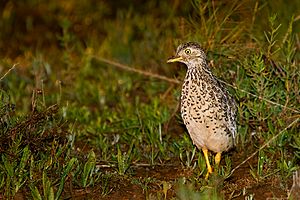Plains-wanderer facts for kids
Quick facts for kids Plains-wanderer |
|
|---|---|
 |
|
| Conservation status | |
| Scientific classification | |
| Genus: |
Pedionomus
|
| Species: |
torquatus
|
The plains-wanderer (Pedionomus torquatus) is a bird, the only representative of family Pedionomidae and genus Pedionomus. It is endemic to Australia. The majority of the remaining population is found in the Riverina region of New South Wales.
Contents
Description
The plains-wanderer is a quail-like ground bird, measuring 15–19 cm. It is such an atypical bird that it is placed in an entire family of its own, Pedionomidae. The adult male is light brown above, with fawn-white underparts with black crescents. The adult female is substantially larger than the male, and has a distinctive white-spotted black collar. They have excellent camouflage, and will first hide at any disturbance. If they're approached too closely, they will run rather than flying at which they are very poor. Females lay four eggs, which the male then incubates.
Taxonomy
It was formerly believed to be related to the buttonquails and thus placed in the gamebird order Galliformes or with the cranes and rails in Gruiformes. DNA-DNA hybridization and RAG-1 sequence data places it as a wader related to the jacanas (Sibley & Ahlquist 1990, Paton et al. 2003, Thomas et al. 2004, van Tuinen et al. 2004). It thus represents a remarkable case of morphological convergence, or perhaps it is simply extremely plesiomorphic in morphology (the buttonquails, meanwhile, having turned out to be a very basal offshoot of the wader radiation). In the latter case, this would mean that the jacanas, painted snipe and seedsnipes – all ecologically very different birds – all evolved from birds very similar to the living plains-wanderer.
Status and conservation
Population decline has been caused by the conversion of native grasslands to cultivation and intensive predation by the introduced fox — the species' ground-nesting habits, poor flying ability, and tendency to run rather than fly from predators make it easy prey for the introduced fox. Sites identified by BirdLife International as being important for plains-wanderer conservation are Boolcoomatta, Bindarrah and Kalkaroo Stations in north-eastern South Australia, Diamantina and Astrebla Grasslands in western Queensland, Patho Plains in northern Victoria and the Riverina Plains in New South Wales.
International
This bird is listed as Critically Endangered on the 2018 IUCN Red List.
Australia
Plains-wanderers are listed as Critically Endangered on the Australian Environment Protection and Biodiversity Conservation Act 1999 (EPBC). Their conservation status also varies from state to state within Australia. For example:
- The plains-wanderer is listed as Critically Endangered on the Victorian Flora and Fauna Guarantee Act (1988). Under this Act, an Action Statement for the recovery and future management of this species has been prepared.
- The plains-wanderer is listed as Endangered on Schedule 1 of the NSW Threatened Species Conservation Act 1995 (now Biodiversity Conservation Act 2016).
Conservation Efforts
A captive population was established in late-2018 within a purpose-built facility containing 30 aviaries at Taronga Western Plains Zoo in Dubbo. These captive individuals will form an insurance population as part of a breed-and-release program to support the wild population.
See also
 In Spanish: Torillo australiano para niños
In Spanish: Torillo australiano para niños


